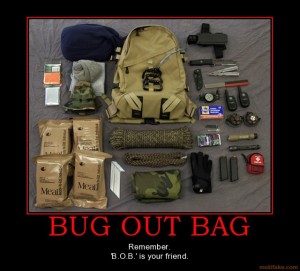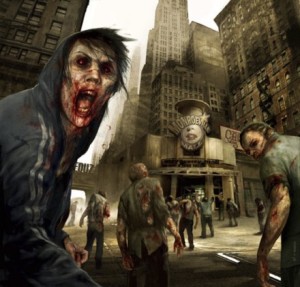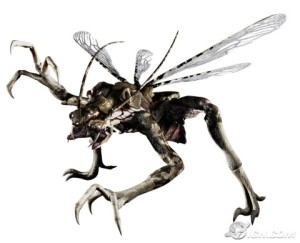Tag Archives: Megastore
Kansas militia expects zombies, and it’s dead serious
It’s got to be one of the coolest names ever for a group:
The Kansas Anti Zombie Militia.
But the group is real and its members are pretty serious about it.
Once the Zombie Apocalypse hits, they’ll be ready for it and they want you to be too.
“Can a natural person change into this monster that many fear?” Alfredo Carbajal, the militia’s main spokesman, said in an interview. “The possibilities are yes, it can happen. We have seen incidents that are very close to it, and we are thinking it is more possible than people think.”
Carbajal and other true believers aren’t so much scared of movie zombies. The apocalypse they see coming is a pandemic spread by a virus that creates zombie-like symptoms.
Last month, the Discovery Channel featured the Kansas militia in a documentary that concluded that such a Zombie Apocalypse — or Zompoc — was possible. The program featured scientists who speculated some evolving virus is bound to jump to humans on our overcrowded planet.
Of course, scientists have been warning about pandemics such as bird flu that don’t produce zombies, but zombies are the hot monsters right now.
A packed house listened last year at St. Mary’s College of Maryland as a chemist, psychologist and student acknowledged the possibility of an epidemic, according to the school’s newspaper.
The panel pointed out that there already have been zombie-like symptoms dating back to 1594; they were eventually determined to be the first recorded human case of furious rabies — an especially serious form of rabies.
Carbajal, 28, didn’t start out as a zombie fighter.
He and several friends grew up in Wamego, home of the Oz museum, watching zombie movies like “Shaun of the Dead,” “28 Days Later” and “Night of the Living Dead” and playing video games like the Left 4 Dead video game series.
The friends designed a web page for fun but then they began wondering what to do if there was actually a zompoc, and their thinking turned serious.
The group has five founders but about 1,500 likes on its Facebook page.
It’s not all zombie crusading; the militia also sponsors a Zombie Walk in October to raise money and food for charities.
But the group’s website points out that the militia is committed to research and preparing for a zompoc.
“We are not crazy. We are not paranoid. We believe in preparedness in any situation,” it says.
Everything you need to know about surviving a zombie attack can be found on the militia’s website — never take on a small horde of zombies by yourself because that would be suicide, and make sure all your skin is covered because blood spatters can be infectious.
Blunt objects are better to use than, say, knives because blades tend to dull after each use. A metal bat and a collapsible baton are the two most recommended weapons.
The site also notes as “a real-life threat to humanity” a biosecurity lab planned near Manhattan, Kan.
Carbajal and his group are not alone in their deep fascination over zombies. Much of the country has been touched.
The “Walking Dead” cable series broke basic cable ratings records with more than 10 million viewers for the first show of season three. And already hype for a movie, based on the book “World War Z,” is widespread even though its release date is six months out.
How-to books have been published in recent years, including the “Zombie Survival Guide,” which made the New York Times Best Seller List, and the “Zombie Combat Manual,” which warns “During a zombie outbreak, 98% of individuals will have to destroy an undead opponent without the aid of a firearm. Will you be ready?”
Carbajal said that if you aren’t a true believer, just being prepared for any apocalypse or natural disaster is a good thing.
“My thought is if you are ready for zombies, you are ready for anything, whether it be natural disasters, fall of government, invasion from another country — the possibilities are endless,” he said. “The point is to keep yourself and your loved ones safe.”
Others agree.
Using the guise of a zombie apocalypse, the Centers for Disease Control and Prevention and state emergency management agencies are trying to get people to be prepared for a natural disaster with at least several days of food and supplies, copies of important documents and a plan.
“It’s a spoof; we are not encouraging a zombie scare,” said Devan Tucking-Strickler, Kansas Division of Emergency Management spokeswoman. “We use the tagline, ‘If you are prepared for zombies, you are prepared for anything and prepared for the unexpected.’ ”
Kansas even used the militia to help promote general disaster awareness.
Members of the group were featured in a photograph with Gov. Sam Brownback when he signed a proclamation declaring October as Zombie Preparedness Month in Kansas.
A little preparation for disaster can prove very important later, but most people don’t prepare, said another viral disaster worrier, Shawn Beatty, who also was featured on the Discovery documentary.
“You can get a first aid kit for $100, something that you should have in your house anyway, or you can go to dinner, take a trip, or have a really nice night out with that $100,” said Beatty, a public-school teacher in Columbia. “Who is going to say, ‘Let’s go buy something that you may not use?’
Zombies A Factor In Gun Sales Increase, Gun Rights Advocate Says
 It’s not just President Obama’s re-election that’s lead to a spike in gun sales. The living dead are also providing a reason to stock up on firearms and ammo.
It’s not just President Obama’s re-election that’s lead to a spike in gun sales. The living dead are also providing a reason to stock up on firearms and ammo.
My Northwest.com reports that, according to FBI data, background checks for guns rose 20 percent on Black Friday from the same day last year. According to KIRO, one gun rights advocate said part of the reason for the increase is zombies.
“A lot of people appear to be really enthralled by this,” Dave Workman said. “I’ve seen lines of zombie targets, I know one or two ammunition companies have introduced boxes, lines of cartridges they called zombie cartridges, shotgun shells and rifle shells.”
The zombie-themed merchandise has ushered in a new generation of gun shooters, according to Workman.
Of course, the popularity of TV’s “Walking Dead,” heralds the coming of a zombie apocalypse for which we must prepare.
Those sentiments were echoed earlier this year by Texas gun purveyor Cris Parsons in an interview with ABC News.
He said products like Zombie Max ammunition (slogan: “just in case”) made by Hornady Manufacturing fly off the shelves.
“We can’t keep it in stock,” Parsons said. “It comes in a cool, colorful box with a Zombie on it.”
Clearly zombies are hot with gun fans, but what about other weapons? Could they too become the beneficiaries of a “zombie bump”? Absolutely, according to Detroit Free Press’ Eric Millikin.
“Zombies are also sure to increase sales of machetes, nunchucks, and prosthetic chainsaw hands,” he writes.
Dept. of Homeland Security Warns of Impending Zombie Apocalypse
 If there’s one thing Americans love, it’s the zombie apocalypse. I don’t know why, really. Although some people think that it would be cool to blow the heads off the undead and attempt to survive in a brutal post-apocalyptic landscape, most people would get their fat asses either gnawed on by zombies or shot by a survivalist looking for supplies. The harsh reality is that most people wouldn’t survive the zombie apocalypse, but we can keep dreaming that we’re the exception – we’re all Rick from The Walking Dead.
If there’s one thing Americans love, it’s the zombie apocalypse. I don’t know why, really. Although some people think that it would be cool to blow the heads off the undead and attempt to survive in a brutal post-apocalyptic landscape, most people would get their fat asses either gnawed on by zombies or shot by a survivalist looking for supplies. The harsh reality is that most people wouldn’t survive the zombie apocalypse, but we can keep dreaming that we’re the exception – we’re all Rick from The Walking Dead.
This month is National Preparedness Month, and the Department of Homeland Security is capitalizing on the never-ending zombie craze to make people start thinking about what they would do in the event of a disaster.
According to the AP, DHS is urging citizens to prepare for the zombie apocalypse. “The Zombies are coming!” they say.
Except they’re not. At least not right now. DHS’s message is that if you’re prepared for a zombie attack, you’ll likely be prepared for a hurricane, pandemic, earthquake, or terrorist attack. That’s because all of those events have something in common – the need for shelter, food, water, etc. DHS wants emergency planners across the country to use the “zombie attack” trope to get people into the disaster preparedness mindset.
Of course, this isn’t the first time that a government organization has mentioned the z word to citizens. Last year, the Centers for Disease Control actually acknowledged zombies and released their own zombie preparedness guide.
Here’s what the CDC says would happen, on a governmental response level:
If zombies did start roaming the streets, CDC would conduct an investigation much like any other disease outbreak. CDC would provide technical assistance to cities, states, or international partners dealing with a zombie infestation. This assistance might include consultation, lab testing and analysis, patient management and care, tracking of contacts, and infection control (including isolation and quarantine).
It’s likely that an investigation of this scenario would seek to accomplish several goals: determine the cause of the illness, the source of the infection/virus/toxin, learn how it is transmitted and how readily it is spread, how to break the cycle of transmission and thus prevent further cases, and how patients can best be treated. Not only would scientists be working to identify the cause and cure of the zombie outbreak, but CDC and other federal agencies would send medical teams and first responders to help those in affected areas (I will be volunteering the young nameless disease detectives for the field work).
Even though the CDC clearly has a plan, they officially denied the known existence of zombies after a rash of cannibalism stories hit the news earlier this year.
If you have the money and truly wish to prepare for the zombie apocalypse, you can’t go wrong with this kit for the 1%.
Fly turns honeybees into little zombies
Latest woe is horrific, but is not what’s crashing bee populations
A researcher at Oregon State University has reported Oregon’s first documented case of a “zombie” fly infecting a honeybee, but he doubts that the parasite at the moment poses a threat to the bee, which is a vital pollinator of some of the state’s key crops.
Ramesh Sagili, a honeybee specialist with the OSU Extension Service, stumbled upon a belly-up bee on a sidewalk under a street light on campus in Corvallis one morning in late July, according to a press release Tuesday from OSU. He placed it in a vial in his lab, and four days later seven maggots crawled out of the bee’s neck. Almost three weeks after that, one matured into an Apocephalus borealis fly, commonly called a zombie fly because of the disoriented behavior it is suspected of causing the bees to exhibit at night.
The finding comes amid rising concern about the health of honeybees, which have been hit by a mysterious phenomenon called colony collapse disorder in which adult honeybees disappear from a hive, either entirely or in large numbers. It came to light in late 2006 when beekeepers on the East Coast began to see their honeybee colonies dwindle. The disorder has since spread to other states. A cause has not been determined, but suspects include mites, viruses, malnutrition, pesticides, a lack of genetic diversity, and stress that results from commercial hives being trucked around the country to pollinate crops.
Sagili doubts that the fly is playing a role in the widespread die-off of honeybees, which are crucial pollinators for various Oregon crops, including blueberries, pears, cherries, apples, clover, cranberries and vegetable seeds.
“It’s a stretch to say the fly is correlated to colony collapse disorder,” he said. “At this point, I don’t think it’s a threat. I don’t think it’s at the level where it can depopulate hives in large numbers.”
Earlier this year in a journal article, researchers in California became the first to document that the fly attacks honeybees. They discovered the parasite in honeybees in California and South Dakota, the only states besides Oregon where fly-infected honeybees, or ZomBees, have been reported.
The fly is known to parasitize bumblebees but little is known about its impact on them in Oregon, said Sujaya Rao, an entomologist at OSU.
Sagili hypothesizes that the fly is just now being found in honeybees because it may be trying to branch out from its other hosts when they’re not available. He added that although honeybees are widely studied, it’s possible that scientists just never saw the parasite because they usually preserve their collected bees in alcohol, which would kill the larvae and keep them from popping out.
The brownish-red fly lays its eggs inside the bees and is smaller than a fruit fly, is native to North America and has been found in Canada and states including Alaska, Georgia, Maine, Minnesota, New Mexico and New York, said Brian Brown, the curator of entomology at the Natural History Museum of Los Angeles County and an expert on the parasitic fly.
Brown said the fly has been in Oregon for thousands of years, but it just never has been found in a honeybee in the state until no
ZOMBIE OUTBREAK – Face-chewing victim speaks out in police interview
MIAMI — A homeless man whose face was mostly chewed off in a bizarre assault  alongside a busy South Florida highway told police that his attacker “just ripped me to ribbons.”
alongside a busy South Florida highway told police that his attacker “just ripped me to ribbons.”
In a recorded interview with investigators, Ronald Poppo said the man who approached him initially seemed friendly. Then the man, Rudy Eugene, seemed to become angry about something that had happened on Miami Beach, where thousands were partying through the Memorial Day weekend.
“For a while he was acting nice. Then he got flustered. He probably remembered something that happened on the beach and was not happy about it,” Poppo told investigators in the interview that was taped July 19 and first reported Wednesday by Miami news station WFOR-TV (http://cbsloc.al/OQgwOt).
Poppo said Eugene then “turned berserk” and attacked with his bare hands, screaming that both men would die.
“He just ripped me to ribbons. He chewed up my face. He plucked out my eyes. Basically, that’s all there is to say about it,” Poppo said.
Poppo, 65, remains in a long-term care facility after losing an eye, his eyebrows, his nose and parts of his forehead and right cheek in the May 26 attack. His other eye was severely damaged.
Doctors at Jackson Memorial Hospital’s Ryder Trauma Center said last month that Poppo was in good spirits, talking and walking around, but would need several more surgeries before he could explore the options for reconstructing his face.
Eugene, 31, was shot and killed by a Miami police officer during the attack on the Macarthur Causeway just off downtown Miami. Lab tests found only marijuana in Eugene’s system, but no other drugs or alcohol.
Poppo said Eugene had said something about not being able “to score,” adding that Eugene “must have been souped up on something.”
In the police interview, Poppo sometimes seems confused about some details of the attack. He described Eugene wearing a green shirt and getting out of a car, but surveillance video recorded from security cameras on The Miami Herald building showed a naked Eugene walking up to Poppo as cars and bicyclists zipped by. Poppo was reclining on the sidewalk near the parking garage where he lived.
Police asked Poppo whether he provoked Eugene.
“What could provoke an attack of that type?” Poppo said. “I didn’t curse at the guy or say anything mean or nasty.”
Poppo also thanked the police for saving his life, saying the officer who shot Eugene arrived in the nick of time.
